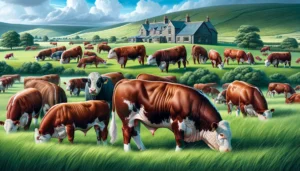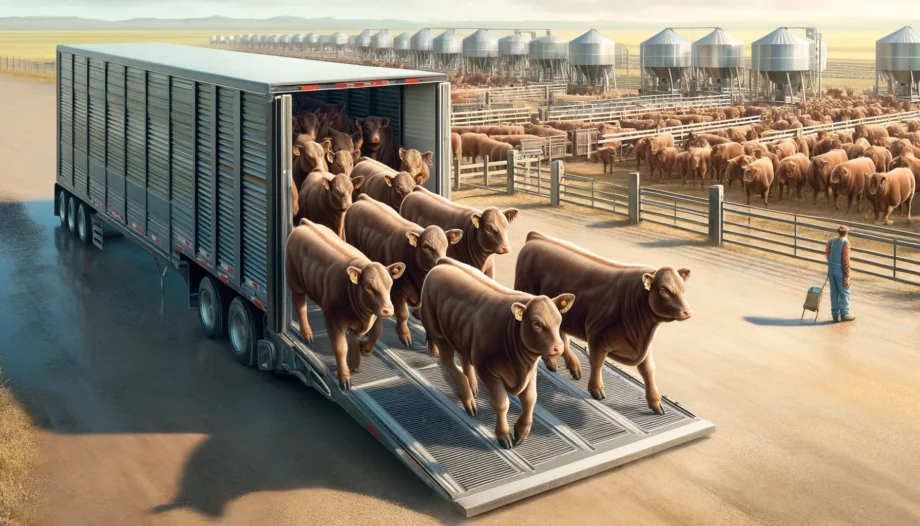Raising Beef Cattle and Beef Management and Production
Introduction to Raising Beef Cattle
Raising beef cattle is a rewarding and potentially profitable agricultural venture that requires careful planning, knowledge, and management. Beef cattle farming involves breeding, raising, and caring for cattle specifically for meat production. This comprehensive guide covers all aspects of beef cattle management, from selecting breeds to marketing the final product, providing farmers with the tools they need to succeed in this industry.
Selecting Beef Cattle Breeds
Popular Beef Cattle Breeds
Different cattle breeds offer various advantages depending on the production goals and environmental conditions. Some of the most popular beef cattle breeds include:
- Angus: Known for their high-quality meat and excellent marbling, Angus cattle are a popular choice for beef production.
- Hereford: Renowned for their hardiness and efficient weight gain, Herefords are well-suited for various climates.
- Charolais: These large, muscular cattle are valued for their fast growth rates and lean meat.
- Simmental: Simmentals are dual-purpose cattle used for both milk and meat production, known for their size and versatility.
- Limousin: Limousin cattle are recognized for their lean meat and efficient feed conversion.
Factors to Consider When Choosing a Breed
Selecting the right breed involves considering several factors, including:
- Climate Adaptability: Choose breeds that can thrive in the local climate conditions.
- Market Demand: Consider the preferences of local markets and consumers.
- Production Goals: Determine whether the focus is on meat quality, weight gain, or a combination of factors.
- Resource Availability: Assess the availability of feed, water, and pasture to support the chosen breed.
Establishing a Beef Cattle Operation
Farm Infrastructure
Setting up a beef cattle operation requires adequate infrastructure to ensure the health and productivity of the herd. Key components include:
- Shelter: Provide shelters to protect cattle from extreme weather conditions. This can range from simple windbreaks to fully enclosed barns.
- Fencing: Sturdy fencing is essential to contain cattle and protect them from predators. Electric fences or high-tensile wire fences are commonly used.
- Water Supply: Ensure a reliable source of clean water, as cattle require significant amounts of water daily.
- Feeding Areas: Designate specific areas for feeding to prevent competition and waste. Feed bunks and hay racks are useful for this purpose.
Pasture Management
Effective pasture management is crucial for maintaining the health and productivity of beef cattle. Practices include:
- Rotational Grazing: Rotate cattle between pastures to prevent overgrazing and allow forage to recover.
- Forage Quality: Monitor and manage the quality of pasture grasses and legumes to ensure they meet the nutritional needs of the herd.
- Soil Health: Regularly test soil and apply appropriate fertilizers and amendments to maintain soil fertility.
Nutrition and Feeding
Nutritional Requirements
Beef cattle require a balanced diet to ensure optimal growth and health. Key nutritional components include:
- Forage: High-quality pasture, hay, and silage provide the bulk of their diet.
- Grains: Supplementing with grains such as corn, barley, and oats can provide additional energy, particularly for finishing cattle.
- Protein: Protein-rich feeds, such as soybean meal and alfalfa, support muscle development and overall health.
- Minerals and Vitamins: Provide mineral supplements, including salt, calcium, phosphorus, and trace minerals, to meet their dietary needs.
Feeding Strategies
Developing effective feeding strategies involves:
- Age and Stage of Production: Adjust feeding programs based on the age and stage of production (e.g., growing calves, lactating cows, finishing cattle).
- Feed Efficiency: Monitor feed intake and growth rates to ensure efficient feed conversion.
- Cost Management: Balance the cost of feed with the nutritional needs of the herd to maintain profitability.
Breeding and Reproduction
Breeding Methods
Breeding methods for beef cattle include:
- Natural Breeding: Using bulls for natural mating is a common and effective method.
- Artificial Insemination (AI): AI allows for selective breeding and genetic improvement by using semen from superior bulls.
- Embryo Transfer: This advanced technique involves implanting embryos from high-quality cows into surrogate mothers.
Breeding Season
Managing the breeding season involves:
- Estrus Detection: Identifying when cows are in heat to ensure successful mating.
- Breeding Schedule: Planning breeding to align with optimal calving times, typically in spring or fall.
Gestation and Calving
The gestation period for beef cattle is approximately 283 days. Key considerations for calving include:
- Nutrition: Ensure pregnant cows receive adequate nutrition to support fetal development and prepare for lactation.
- Calving Facilities: Provide clean, dry, and safe environments for calving.
- Monitoring: Closely monitor cows during calving to assist with any complications and ensure the health of both the cow and calf.
Health Management
Common Health Issues
Beef cattle are susceptible to various health issues, including:
- Respiratory Diseases: Infections such as pneumonia can affect cattle, particularly in young calves.
- Digestive Disorders: Issues like bloat and acidosis can occur, especially when cattle consume high-grain diets.
- Parasites: Internal and external parasites, such as worms and lice, can impact health and productivity.
Preventative Health Care
Implementing preventative health care practices is essential to maintaining a healthy herd:
- Vaccinations: Regular vaccination programs protect cattle from common diseases.
- Deworming: Administer deworming treatments to control internal parasites.
- Biosecurity: Implement biosecurity measures to prevent the introduction and spread of diseases.
- Regular Health Checks: Conduct routine health checks and work with a veterinarian to develop a comprehensive herd health plan.
Veterinary Care
Establishing a relationship with a qualified veterinarian is crucial for addressing health issues and ensuring the overall well-being of the herd. Regular veterinary visits and prompt attention to any health concerns can prevent minor issues from becoming major problems.
Beef Cattle Management
Record Keeping
Maintaining accurate records is vital for effective cattle management. Key records include:
- Breeding Records: Track mating dates, sires used, and calving outcomes.
- Health Records: Document vaccinations, treatments, and any health issues.
- Feeding Records: Monitor feed consumption and growth rates.
- Financial Records: Keep detailed financial records to track expenses and revenues.
Handling and Safety
Proper handling and safety practices are essential for both cattle and handlers. Considerations include:
- Handling Facilities: Use well-designed handling facilities, such as chutes and pens, to minimize stress and injury.
- Low-Stress Handling: Employ low-stress handling techniques to improve cattle welfare and ease of management.
- Safety Gear: Ensure handlers wear appropriate safety gear and receive training in safe handling practices.
Marketing and Sales
Successfully marketing and selling beef involves understanding market dynamics and developing effective strategies:
- Market Research: Stay informed about market trends and consumer preferences.
- Direct Sales: Selling directly to consumers, through farmers’ markets or on-farm sales, can yield higher prices.
- Wholesale and Retail: Partnering with local retailers, restaurants, and processors can expand market reach.
- Value-Added Products: Developing value-added products, such as specialty cuts or branded beef, can enhance profitability.
Sustainability and Environmental Impact
Sustainable Farming Practices
Adopting sustainable farming practices helps ensure the long-term viability of beef cattle operations. Key practices include:
- Rotational Grazing: Rotating cattle between pastures to promote forage regrowth and soil health.
- Integrated Pest Management: Using integrated pest management techniques to reduce reliance on chemical treatments.
- Conservation Practices: Implementing conservation practices, such as riparian buffers and erosion control, to protect natural resources.
Environmental Benefits
Beef cattle farming can have positive environmental impacts when managed responsibly:
- Carbon Sequestration: Well-managed pastures and grasslands can sequester carbon, mitigating greenhouse gas emissions.
- Biodiversity: Grazing cattle can help maintain and enhance biodiversity in pastures and rangelands.
Challenges and Considerations
While beef cattle farming offers numerous benefits, it also presents challenges that require careful management:
- Climate Variability: Adapting to changing climate conditions and extreme weather events is crucial.
- Resource Management: Efficiently managing resources such as water, feed, and pasture is essential for sustainability.
- Animal Welfare: Ensuring high standards of animal welfare is critical for ethical and sustainable beef production.
Advanced Topics in Beef Cattle Management
Genetic Improvement
Genetic improvement involves selecting and breeding cattle to enhance desirable traits such as growth rate, feed efficiency, and meat quality. Techniques include:
- Selection Indexes: Using selection indexes to evaluate and rank animals based on multiple traits.
- Genomic Testing: Implementing genomic testing to identify animals with superior genetic potential.
- Crossbreeding: Utilizing crossbreeding programs to combine the strengths of different breeds and improve overall herd performance.
Feedlot Management
Feedlots are specialized facilities where cattle are finished on high-energy diets to achieve optimal weight and meat quality. Key aspects of feedlot management include:
- Diet Formulation: Developing balanced diets that promote rapid weight gain and marbling.
- Health Monitoring: Implementing health monitoring and preventative care programs to reduce the risk of disease outbreaks.
- Environmental Management: Managing waste and emissions to minimize environmental impact.
Direct-to-Consumer Beef Sales
Direct-to-consumer sales can provide higher returns compared to traditional marketing channels. Strategies for success include:
- Brand Development: Creating a strong brand that resonates with consumers and communicates the quality and value of the product.
- Online Sales: Leveraging e-commerce platforms to reach a broader audience and facilitate convenient purchasing.
- Customer Engagement: Building relationships with customers through farm tours, newsletters, and social media.
Organic and Grass-Fed Beef Production
Producing organic and grass-fed beef can appeal to health-conscious and environmentally aware consumers. Key practices include:
- Organic Certification: Adhering to organic certification standards, including the use of organic feed and avoiding synthetic chemicals.
- Grass-Fed Protocols: Managing cattle on pasture-based diets without grain supplementation to meet grass-fed certification requirements.
- Marketing and Education: Educating consumers about the benefits of organic and grass-fed beef to differentiate the product in the market.
International Beef Trade
Understanding the dynamics of international beef trade can open new opportunities for beef producers. Key considerations include:
- Export Regulations: Navigating export regulations and certifications required for international trade.
- Market Analysis: Analyzing potential markets and understanding consumer preferences in different countries.
- Trade Agreements: Leveraging trade agreements to access new markets and reduce trade barriers.
Case Studies
Successful Beef Cattle Operations
Smith Family Farms in Texas has successfully integrated rotational grazing, genetic improvement, and direct-to-consumer sales to create a profitable and sustainable beef operation. By focusing on high-quality Angus cattle and developing a strong brand, they have built a loyal customer base and consistently achieve premium prices for their beef.
Green Acres Ranch in California specializes in organic and grass-fed beef production. Their commitment to sustainable farming practices and animal welfare has earned them organic certification and a reputation for high-quality beef. They have successfully marketed their products through farmers’ markets, local retailers, and online sales.
Lessons Learned
Successful beef cattle farmers emphasize the importance of:
- Continuous Learning: Staying informed about industry trends, new technologies, and best practices.
- Diversification: Exploring multiple revenue streams and market channels to enhance financial stability.
- Networking: Building relationships with other farmers, industry experts, and consumers to share knowledge and resources.
- Adaptability: Being adaptable and open to change in response to market demands and environmental conditions.
Conclusion
Raising beef cattle and managing beef production requires a comprehensive understanding of various aspects, from breed selection and nutrition to health management and marketing. By implementing best practices and staying informed about industry trends, farmers can achieve success in beef cattle farming. Sustainable practices, effective management, and a commitment to animal welfare are essential for long-term profitability and the well-being of the herd. Whether starting a new operation or improving an existing one, this guide provides valuable insights and strategies to help farmers thrive in the beef cattle industry.
Beef Cattle Image Gallery




